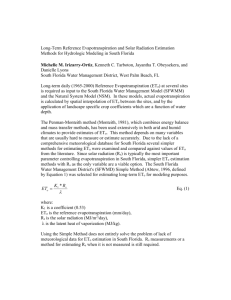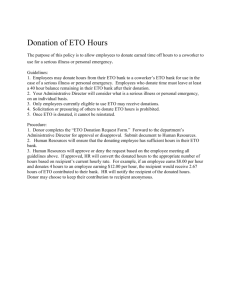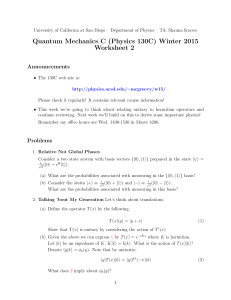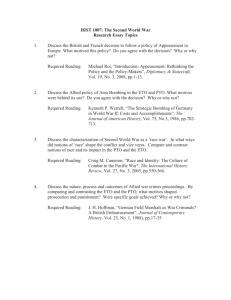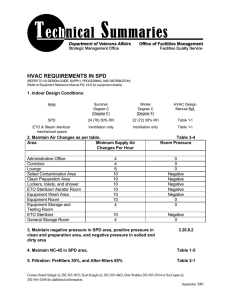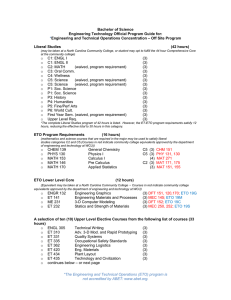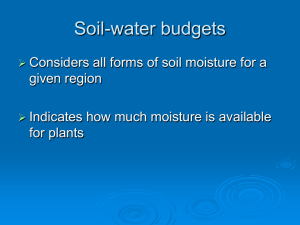ESTIMATION OF EVAPOTRANSPIRATION IN AN EXPERIMENTAL WATERSHED IN
advertisement
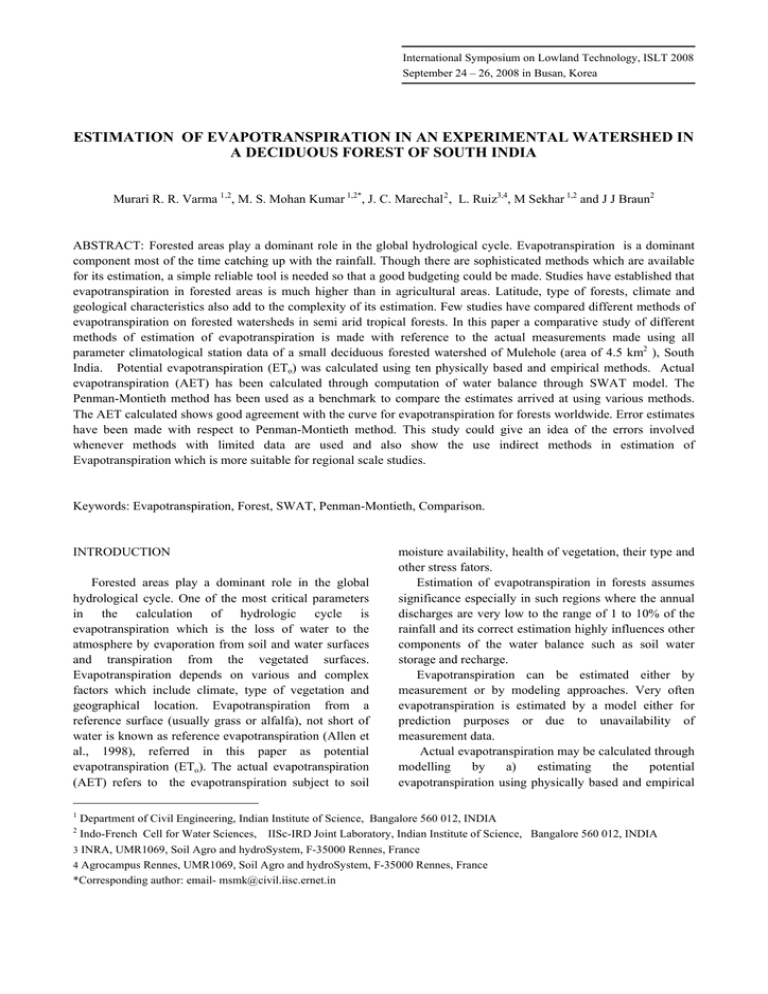
International Symposium on Lowland Technology, ISLT 2008 September 24 – 26, 2008 in Busan, Korea ESTIMATION OF EVAPOTRANSPIRATION IN AN EXPERIMENTAL WATERSHED IN A DECIDUOUS FOREST OF SOUTH INDIA Murari R. R. Varma 1,2, M. S. Mohan Kumar 1,2*, J. C. Marechal 2 , L. Ruiz3,4, M Sekhar 1,2 and J J Braun2 ABSTRACT: Forested areas play a dominant role in the global hydrological cycle. Evapotranspiration is a dominant component most of the time catching up with the rainfall. Though there are sophisticated methods which are available for its estimation, a simple reliable tool is needed so that a good budgeting could be made. Studies have established that evapotranspiration in forested areas is much higher than in agricultural areas. Latitude, type of forests, climate and geological characteristics also add to the complexity of its estimation. Few studies have compared different methods of evapotranspiration on forested watersheds in semi arid tropical forests. In this paper a comparative study of different methods of estimation of evapotranspiration is made with reference to the actual measurements made using all parameter climatological station data of a small deciduous forested watershed of Mulehole (area of 4.5 km2 ), South India. Potential evapotranspiration (ETo) was calculated using ten physically based and empirical methods. Actual evapotranspiration (AET) has been calculated through computation of water balance through SWAT model. The Penman-Montieth method has been used as a benchmark to compare the estimates arrived at using various methods. The AET calculated shows good agreement with the curve for evapotranspiration for forests worldwide. Error estimates have been made with respect to Penman-Montieth method. This study could give an idea of the errors involved whenever methods with limited data are used and also show the use indirect methods in estimation of Evapotranspiration which is more suitable for regional scale studies. Keywords: Evapotranspiration, Forest, SWAT, Penman-Montieth, Comparison. INTRODUCTION Forested areas play a dominant role in the global hydrological cycle. One of the most critical parameters in the calculation of hydrologic cycle is evapotranspiration which is the loss of water to the atmosphere by evaporation from soil and water surfaces and transpiration from the vegetated surfaces. Evapotranspiration depends on various and complex factors which include climate, type of vegetation and geographical location. Evapotranspiration from a reference surface (usually grass or alfalfa), not short of water is known as reference evapotranspiration (Allen et al., 1998), referred in this paper as potential evapotranspiration (ETo). The actual evapotranspiration (AET) refers to the evapotranspiration subject to soil 1 moisture availability, health of vegetation, their type and other stress fators. Estimation of evapotranspiration in forests assumes significance especially in such regions where the annual discharges are very low to the range of 1 to 10% of the rainfall and its correct estimation highly influences other components of the water balance such as soil water storage and recharge. Evapotranspiration can be estimated either by measurement or by modeling approaches. Very often evapotranspiration is estimated by a model either for prediction purposes or due to unavailability of measurement data. Actual evapotranspiration may be calculated through modelling by a) estimating the potential evapotranspiration using physically based and empirical Department of Civil Engineering, Indian Institute of Science, Bangalore 560 012, INDIA Indo-French Cell for Water Sciences, IISc-IRD Joint Laboratory, Indian Institute of Science, Bangalore 560 012, INDIA 3 INRA, UMR1069, Soil Agro and hydroSystem, F-35000 Rennes, France 4 Agrocampus Rennes, UMR1069, Soil Agro and hydroSystem, F-35000 Rennes, France *Corresponding author: email- msmk@civil.iisc.ernet.in 2 equations, using a crop coefficient to deduce the maximal evapotranspiration and then a soil water balance modelling to calculate the actual evapotranspiration b) by using analytical methods. The first method is very popular for land uses where specific crop coefficients are available (Allen et al., 1998). The analytical approach uses equation like Penman-Montieth to calculate AET; however this approach needs accurate estimate of the canopy resistance term when applied to water stress conditions. In the present study, the model SWAT (Soil Water Assessment Tool) (Arnold et al, 1998) has been used to estimate AET using water balance approach. For this the ETo was first estimated. Ten different methods have been used to calculate ETo to compare their performance. ETo has been used as reference to calculate AET through SWAT model. Several studies carried out in India compared the performance of the different methods of estimation of ETo. Nandagiri and Kovoor (2006) compared various ETo methods to the Penman-Montieth method in four climate regimes (namely humid, sub-humid, semi-arid, arid) using data from four stations and compared suitability of these methods. Mohan (1991) compared reference evapotranspiration estimates by four methods using mean monthly data in various climatic subregimes of Tamil nadu and suggested suitabilty of each. The present study focuses on the estimation of ETo in a transition region of a unique climatic gradient and subsequently AET from this decidous forest. STUDY AREA The present study has been conducted at Mulehole experimental watershed, located in a deciduous forest in South India (Figure 1). The area lies on the leeward side of the Western Ghats stretching parallel to the west coast of the South Indian peninsula which forms an orographic barrier inducing summer monsoon rains and presents a unique climosequence. The annual rainfall decreases progressively from West to East from 5000 mm to 750 mm within a distance of about 80 km. This tropical climosequence although much steeper, is comparable to well documented monsoonal West African and the Northeast Brazilian climosequences (Gunnell, 1998, 2000). The Mulehole watershed has an area of 4.54 km2 spreading between 11º43′41″ N to 11º44′45″ N Latitude and 76º25′55″ E to 76º27′40″ E Longitude. The annual average rainfall is 1120 mm over a 25 year period (1976-1996 ; 2003-2006). The Rainy season is usually in stages viz. the South West Monsoon (June to September) and North East Monsoon (October December) with dominant rainfall occurring during North East Monsoon. On the basis of the aridity index defined as the ratio of annual average rainfall (P) to potential evapotranspiration (ETo) : AI = P/ETo ≈ 1.2, hence the climate regime can be classified as humid [UNESCO, 1979] . The elevation in the watershed varies from 820 m to 910 m above MSL. Fig. 1 Study Area The climatic monitoring of the watershed is being carried out from July 2003. An automatic weather station at the Mulehole Forest check post, which is about 1.5 km west to the watershed outlet, (CIMEL, type ENERCO 407 AVKP) has been used to monitor climatic data. hourly and daily rainfall, temperature, relative humidity, global radiation, wind speed and wind direction are measured at this weather station. Daily values were used to calculate daily ETo. Stream discharge measured at the outlet since August 2003 was also available for model calibration. The soil distribution consists of two types; red soil (Ferralsols and Chromic Luvisols) and black soil (Vertisols and Vertic intergrades) (Barbiero et al., 2007). The ground water levels are also being monitored using 12 piezometers. Geophysical studies (Descloitres et al, 2008) revealed the presence of a weathered zone with an average depth of 17 m in the watershed. The water levels of piezometers vary in the range 2-12m near the stream and 38-40 m in piezometers in the ridge portions. This also suggests a high soil storage in the watershed. The data required for AET computations using SWAT include the DEM data, soil and landuse maps. METHODOLOGY Measurement is the best way of estimating the actual evapotranspiration. However, in the absence of measured data, the evapotranspiration may be modelled from the soil water balance. The actual evapotranspiration in forest depends on the climatic potential as well as various limiting factors such as moisture availability, types of vegetation, their physiological characteristics among others. Table 1. Methods used for calculating potential evapotranspiration (ETo ) Method Acronym Reference Type PenmanMontieth PM Neitsch et al. (2002) Combination Priestly-Taylor PT Hargreaves HARG Makkink MAK (Allen (2001) Turc Turc (Allen, 2001) FAO BlaneyCriddle BC Allen and pruitt (1991) Radiation based Temperature based Radiation based Radiation based Temperature based FAO Radiation FAOrad Hammon HMN Rs based Rs Rn based Rn Allen and pruitt (1991) Alkaeed et al. 2006 (Irmak et al., 2003) (Irmak et al., 2003) Radiation based Radiation based Radiation based Radiation based Neitsch et al. (2002) Neitsch et al. (2002) In this study the ETo was first computed using the methods listed in Table 1. Many studies world wide have proposed PM as a reference method for estimating potential evapotranspiration eg. (Irmak et al. 2003; Nandagiri and Kovoor, 2006; Slavisa 2007). The PM method was used as an index to compare the other ETo methods. The model SWAT, a physically based, semidistributed, model was used to calculate AET using the SWAT model using water balance. The detailed description and model studies are available from Arnold et al. (1998), Arnold and Fohrer (2005). The model was run on daily time step, using SCS curve number method for computing runoff. The ETo was computed on a daily time step for four and half years of data (July 2003 to December 2007).The model SWAT has inherent algorithms for computation of PM, Priestly Taylor and Hargreaves method. SWAT computes ETo for PM using alfalfa as reference crop at a height of 40 cm with a minimum leaf resistance of 100 s m-1. The other parameters used are described in the SWAT manual (Neitsch et al. 2002). ETo using MAK, Turc, BC, FAOrad were computed using REF ET software by Allen (2001). ETo by HMN, Rs and Rn based was computed using MATLAB software. The equations used for the various ETo methods are listed below. Penman-Montieth (PM) method ET = [ ] Δ(H net − G ) + ρ air c p e zo − e z r a λ [Δ + γ (1 + rc ra )] (1) ET is the evapotranspiration (mm d-1), ∆ is the slope of the saturation vapour pressure-temperature curve, de/dT (kPa ˚C-1), Hnet is the net radiation (MJ m-2 d-1), G is the heat flux density to the ground (MJ m-2 d-1), ρair is the air density (kg m-3), cp is the specific heat at constant pressure (MJ kg-1 ˚C-1), eoz is the saturation vapor pressure of air at height z (kPa), ez is the water vapor pressure of air at height z (kPa), γ is the psychrometric constant (kPa ˚C-1), rc is the plant canopy resistance ( s m-1), ra is the diffusion resistance of the air layer (aerodynamic resistance) (s m-1) and λ is the latent heat of vaporization (MJ kg-1). Priestley Taylor (PT) method ETo = α pet (H − G ) Δ × net Δ+γ λ (2) where ETo is the potential evapotranspiration (mm d-1), αpet is a coefficient and is taken as 1.28, G is the heat flux density to the ground (MJ m-2 d-1). All other parameters are as explained in equation 1. Hargreaves (HARG) method ETo = 0.0023(Tmean+17.8)(Tmax- Tmin)HE Ra (3) where Tmean is daily mean air temperature (°C), Tmax is daily maximum air temperature (°C), Tmin is daily minimum air temperature (°C), and Ra is extraterrestrial radiation (MJ m-2 day-1). The mean air temperature in the Hargreaves equation is calculated as an average of Tmax and Tmin and Ra is computed from information on latitude of the site and time of the year. Therefore air temperature is the only parameter that needs to be measured continuously in order to use Eq. 3 and usually HE = 0.5 is used. Makkink (MAK) method R Δ ETo = 0.61 × s − 0.12 Δ + γ 2.45 Rs based (Rs) method ETo = −0.611 + 0.149 R s + 0.079Tmean (4) Rn Based (Rn) method where Rs is the solar radiation and other parameters are as mentioned in equations before. Turc method ⎛ Tmean ⎞⎛ 23.885R s + 50 ⎞ ⎟⎟⎜ ETo = aT 0.013⎜⎜ ⎟ (5) λ ⎠ ⎝ Tmean + 15 ⎠⎝ where the coefficient aT = 1.0 for RHmean ≥ 50%, where RHmean is mean relative humidity (in %) and when RH mean < 50%, aT = (1 + 50 - RHmean)/70. Other parameters are as mentioned before. (6) where a and b are calibrated parameters that are functions of minimum daily relative humidity, mean ratio of actual to possible sunshine hours, Variable p is the mean daily percentage of total annual daytime hours as given in Allen and Pruitt (1991). FAO Radiation (FAOrad) method ⎞ ⎛ Δ ET0 = c⎜⎜ Rs ⎟⎟ ⎠ ⎝Δ+γ ET o = 0 . 489 + 0 . 289 R n + 0 . 023 T mean (10) where Rn (MJ m-2 day-1 ) is net radiation and other parameters are mentioned in equations before. AET was first computed using the ETo(PM) and the model parameters were calibrated againt the measured runoff for the year 2004 and 2005 and validated for the year 2006. Eqs. 2 to 10 are used to compute respective ETo for different methods. With the calibrated SWAT model, AET for each of the method is computed. RESULTS AND DISCUSSION FAO Blaney-Criddle (BC) method ETo = a + b( p(0.46Tmean + 8.13)) (9) The ETo obtained through various methods are listed in Table 2. Except for HARG method which shows high values, all other methods show acceptable consistency. PM appears to be in the lower range for annual ETo estimation. Table 2. Mean Annual ETo at Mulehole using methods given in equations 1 to 10. Method (7) where c parameter is a function of minimum daily relative humidity, mean ratio of actual to possible sunshine hours as given in Allen and Pruitt (1991). PM PT HARG MAK Turc BC FAOrad HMN Rs Rn Mean ETo, mm 981.10 1150.04 1742.00 895.78 1109.80 1147.05 1177.63 1166.10 1178.20 1271.83 Hammon (HMN) method. ETo = 2.1 × H t2es (Tmean + 273.2) (8) where Ht (day) is average number of daylight hours per day and other parameters are mentioned earlier. Although similar studies done in India (Nandagiri and Kovoor, 2006; Mohan, 1991), have shown suitabilty of HARG, Slavisa (2007) refers to studies in which HARG overestimates the evapotranspiration in humid conditions. Further the above study has also suggested adjusted HE of 0.424 instead of 0.5 for the region studied, arrived from comparing with the PenmanMontieth ETo. Allen (1998) also suggests performing a regression of PM ETo with HARG ETo to increase the accuracy of the HARG ETo method given by : PM ETo = a + b (HARG ETo). Although a correction of HARG is required, no attempt of local calibration was performed in this study. Table 3. Statistical estimates of daily ETo over N=1642 days (July 2003 to December 2007), SD is Standard deviation. All values are in mmd-1 Method Mean SD Range Min Max PM 2.67 1.02 5.25 0.20 5.45 PT HARG MAK Turc BC FAOrad HMN Rs Rn 3.26 4.72 2.45 3.03 3.12 3.21 3.20 3.23 3.49 0.88 1.04 0.86 0.90 0.97 1.30 0.23 0.74 0.56 4.76 5.88 4.55 4.72 4.88 6.94 0.69 3.90 3.29 0.67 1.54 0.20 0.68 1.21 0.10 2.85 1.25 1.71 5.43 7.42 4.75 5.40 6.09 7.04 3.54 5.14 5.00 Fig. 3 Annual ET at Mulehole for year 2004, 2005, 2006 and 2007 plotted against the world wide curve given by Zhang et al (2001). Table 4. Regression and Standard error estimates of daily ETo by different methods in relation to PM method. r - correlation coefficient, R2- Coefficient of determination, SEE - Standard error estimate, mmd-1 Method PT HARG MAK Turc BC FAOrad HMN Rs Rn r 0.970 0.872 0.985 0.990 0.980 0.992 0.980 0.993 0.904 R2 0.941 0.761 0.970 0.980 0.960 0.984 0.960 0.985 0.818 SEE 0.248 0.500 0.177 0.143 0.206 0.130 0.205 0.124 0.436 Table 3 shows Rs, Rn and especially HMN gives very small seasonal variations. Hence they may not be suitable for monthly as well as daily computations of ETo . All the methods except HARG and Rn are strongly correlated to PM method (Table 4). It is interesting to note that the BC method, which is only temperature based, gives similar results as radiation based methods. The AET computed for forested watershed of Mulehole using Penman Montieth equation was plotted (Fig. 3) against the forest world wide relationship curve Fig. 4 PM AET/ETo vs AET/ETo of (a) PT (b) HARG (c) MAK (d) Turc (e) BC (f) FAOrad (g) HAMN (h) Rs (i)Rn between rainfall and evapotranspiration given by Zhang (2001) and also is compared to values obtained in a evergreen plantation forest in the Niligiris (Sharda et al. 1988), close to the study site. The AET computed using SWAT was in agreement with the world wide dispersion. Fig. 4 shows the regression estimates of monthly AET calculated through SWAT model using ETo PM method (AET/ETo(PM)) against AET computed using other ETo estimation methods. All methods except Hargreaves method gives acceptable correlation. The present study has shown that FAO Blaney-Criddle method which is temperature based and which require minimum data performs resonably well. CONCLUSIONS All the ETo estimation methods showed agreement with the Penman Montieth method except for Hargreaves method. Hammon, Rn and Rs methods, which gave agreeable annual estimates, may not be suitable for daily as well as seasonal estimation since they are unable to predict the variations. FAO BlaneyCriddle method, needing only temperature data ( which could possible got using indirect technique) shows reliable estimates of ETo, leading to its possible use in regional scale studies. ACKNOWLEDGMENTS This study was supported through the research project “Kabini river basin” of ORE-BVET (Observatoire de Recherche en Environnement-Bassin Versant Expérimen taux Tropicaux, www.orebvet.fr), the French national programs “ECCO-PNRH” and “ACI-Eau” funded by IRD/INSU/CNRS, the Indo-French Centre for the Promotion of Advanced Research (IFCPAR WA-3000), and the Embassy of France in India. We thank, the Karnataka Forest Department for providing the access to the site. REFERENCES Alkaeed, O., Flores, C., Jinno, K., and Tsutsumi, A., (2006). Comparison of Several Reference Evapotranspiration Methods for Itoshima Peninsula Area, Fukuoka, Japan. Memoirs of the Faculty of Engineering, Kyushu University, 66(1). Allen, R.G., and Pruitt, W. O., (1991) FAO 24 Reference evapotranspiration factors Journal of Irrigation and Drainage Engineering, 117(5), 758772 Allen, R.G., Pereira, L.S., Raes, D. and Smith, M., (1998) Crop evapotranspiration: Guidelines for computing crop water requirements. FAO Irrigation and drainage paper. FAO, 78. Allen, R.G., (2001) Manual - REF-ET reference evapotranspiration calculation sofware for FAO and ASCE standardized equations .University of Idaho. Arnold, J.G., Srinivasan, R., Muttiah R. S., and Williams, J. R. (1998) Large area hydrologic modeling and assessment part I: model development, J. Am. Water Resour. Assoc. 34 (1), 73–89. Arnold, J. and Fohrer, N. (2005) SWAT 2000: Current capabilities and research opportunities in applied watershed modelling. Hydrological Processes, 19(3):563–572. Barbiero, L., Parate, H. R., Descloitres, M., Bost, A., Furian, S., Mohan Kumar,M., Kumar, C., and Braun, J. J. (2007). Using a structural approach to identifyrelationships between soil and erosion in a semi-humid forested area, south india.CATENA, 70(3):313–329 Descloitres, M., Ruiz, Sekhar, M., Legchenko, A., Braun, J-J., Mohan Kumar, M. S., and Subramanian, S. (2008) Characterization of seasonal local recharge using electrical resistivity tomography and magnetic resonance sounding. Hydrological Processes, 22(3), 384-394. Gunnell, Y., (1998) Passive margin uplifts and their influence on climatic change and weathering patterns of tropical shield regions. Global and Planetary Change, 18(1-2), 47-57. Gunnell Y., (2000) The characterization of steady state in Earth surface systems: findings from the gradient modelling of an Indian climosequence, Geomorphology, Volume 35,1-2:11-20. Irmak, S., Irmak, A., Allen, R. G., and Jones, J. W. (2003) Solar and Net Radiation-Based Equations to Estimate Reference Evapotranspiration in Humid Climates. Journal of Irrigation and Drainage Engineering, 129(5), 336-347. Mohan, S. (1991) “Intercomparison of evapotranspiration estimates.” Hydrol. Sci. J.,36, 5, 447–460. Nandagiri, L. and Kovoor, G.M., (2006) Performance Evaluation of Reference Evapotranspiration Equations across a Range of Indian Climates. Journal of Irrigation and Drainage Engineering, 132(1), 238-249. Neitsch, S.L., J.G. Arnold, J.R. Kiniry, J.R. Williams, and King, K.W., (2002) Soil and Water Assessment Tool - Theoretical Documentation, version 2000. Temple, TX : Blackland Research Center, Texas Agricultural Experiment Station. Sharda, V., Samraj, P., Chinnamani, S., and Lakshmanan, V. (1988) Hydrological behaviour of the nilgiri subwatersheds as affected by bluegum plantations, part II. monthly water balances at different rainfall and runoff probabilities. Journal of Hydrology,103:347– 355. Trajkovic, S., (2007) Hargreaves versus PenmanMonteith under Humid Conditions. Journal of Irrigation and Drainage Engineering, 133(1), 38-42. UNESCO (1979), Map of the world distribution of arid regions, 54 pp, UNESCO, Paris. Zhang, L., Dawes, W. R., and Walker, G. R. (2001). Response of mean annual evapotranspiration to vegetation changes at catchment scale. Water Resources Research, 37(3):701–708.
